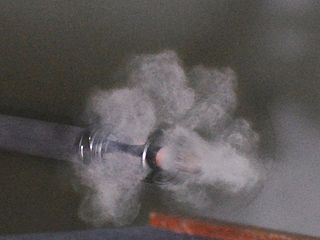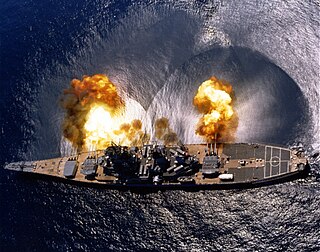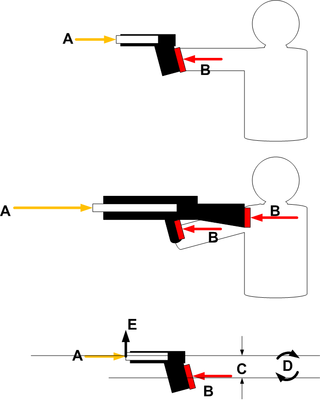
A firearm is any type of gun that uses an explosive charge and is designed to be readily carried and used by an individual. The term is legally defined further in different countries.

A muzzle brake or recoil compensator is a device connected to, or a feature integral to the construction of, the muzzle or barrel of a firearm or cannon that is intended to redirect a portion of propellant gases to counter recoil and unwanted muzzle rise. Barrels with an integral muzzle brake are often said to be ported.

Recoil is the rearward thrust generated when a gun is being discharged. In technical terms, the recoil is a result of conservation of momentum, as according to Newton's third law the force required to accelerate something will evoke an equal but opposite reactional force, which means the forward momentum gained by the projectile and exhaust gases (ejectae) will be mathematically balanced out by an equal and opposite momentum exerted back upon the gun.

A flash suppressor, also known as a flash guard, flash eliminator, flash hider, or flash cone, is a muzzle device attached to the muzzle of a rifle that reduces its visible signature while firing by cooling or dispersing the burning gases that exit the muzzle, a phenomenon typical of carbine-length weapons. Its primary intent is to reduce the chances that the shooter will be blinded in low-light shooting conditions. Contrary to popular belief, it is only a minor secondary benefit if a flash suppressor reduces the intensity of the flash visible to the enemy.

A gun barrel is a crucial part of gun-type weapons such as small firearms, artillery pieces, and air guns. It is the straight shooting tube, usually made of rigid high-strength metal, through which a contained rapid expansion of high-pressure gas(es) is used to propel a projectile out of the front end (muzzle) at a high velocity. The hollow interior of the barrel is called the bore, and the diameter of the bore is called its caliber, usually measured in inches or millimetres.
Internal ballistics, a subfield of ballistics, is the study of the propulsion of a projectile.

A blank is a firearm cartridge that, when fired, does not shoot a projectile like a bullet or pellet, but generates a muzzle flash and an explosive sound like a normal gunshot would. Firearms may need to be modified to allow a blank to cycle the action, and the shooter experiences less recoil with a blank than with a live round. Blanks are often used in prop guns for shooting simulations that have no need for ballistic results, but still demand light and sound effects, such as in historical reenactments, special effects for theatre, movie and television productions, combat training, for signaling, and cowboy mounted shooting. Specialised blank cartridges are also used for their propellant force in fields as varied as construction, shooting sports, and fishing and general recreation.
Blowback is a system of operation for self-loading firearms that obtains energy from the motion of the cartridge case as it is pushed to the rear by expanding gas created by the ignition of the propellant charge.

Transitional ballistics, also known as intermediate ballistics, is the study of a projectile's behavior from the time it leaves the muzzle until the pressure behind the projectile is equalized, so it lies between internal ballistics and external ballistics.

Gas-operation is a system of operation used to provide energy to operate locked breech, autoloading firearms. In gas-operation, a portion of high-pressure gas from the cartridge being fired is used to power a mechanism to dispose of the spent case and insert a new cartridge into the chamber. Energy from the gas is harnessed through either a port in the barrel or a trap at the muzzle. This high-pressure gas impinges on a surface such as a piston head to provide motion for unlocking of the action, extraction of the spent case, ejection, cocking of the hammer or striker, chambering of a fresh cartridge, and locking of the action.

Locked breech is the design of a breech-reloading firearm's action. This is important in understanding how a self-reloading firearm works. In the simplest terms, the locked breech is one way to slow down the opening of the breech of a self-reloading firearm when fired. The source of power for the movement is recoil.

A contact shot is a gunshot wound incurred while the muzzle of the firearm is in direct contact with the body at the moment of discharge. Contact shots are often the result of close-range gunfights, suicide, or execution.

A blank-firing adapter or blank-firing attachment (BFA), sometimes called a blank adapter or blank attachment, is a device used in conjunction with blank ammunition for safety reasons, functional reasons or a combination of them both. Blank firing adapters are required for allowing blank ammunition to cycle the bolts of most semi-automatic and automatic firearms. It can also be a safety feature designed to break up the plugs replacing the bullet in military blanks as well as divert the hot gases from a blank discharge out to the sides, reducing the risk of injury to the target of an aimed shot.
The Ameli is a 5.56mm light machine gun designed for the Spanish Army by the nationally owned and operated Centro de Estudios Técnicos de Materiales Especiales (CETME) small arms research institute.

A muzzle blast is an explosive shockwave created at the muzzle of a firearm during shooting. Before a projectile leaves the gun barrel, it obturates the bore and "plugs up" the pressurized gaseous products of the propellant combustion behind it, essentially containing the gases within a closed system as a neutral element in the overall momentum of the system's physics. However, when the projectile exits the barrel, this functional seal is removed and the highly energetic bore gases are suddenly free to exit the muzzle and rapidly expand in the form of a supersonic shockwave, thus creating the muzzle blast.
The following are terms related to firearms and ammunition topics.

Muzzle rise, muzzle flip or muzzle climb refers to the tendency of a firearm's or airgun's muzzle to rise up after firing. It more specifically refers to the seemingly unpredictable "jump" of the firearm's muzzle, caused by combined recoil from multiple shots being fired in quick succession. It has an adverse effect on maintaining accuracy with using automatic weapons or rapid-firing semi-automatic firearms, as a moving muzzle can throw off the shooter's aim, causing subsequent shots to miss the intended target.

A muzzle shroud, linear compensator, blast shield, forward blast diverter or concussion reduction device (CRD) is a sleeve that attaches to and extends beyond the muzzle of a firearm in order to redirect some of the noise and concussion, or shock wave, from the muzzle blast forward and away from the shooter, and other bystanders, behind and to the sides.
Recoil operation is an operating mechanism used to implement locked-breech autoloading firearms. Recoil operated firearms use the energy of recoil to cycle the action, as opposed to gas operation or blowback operation using the pressure of the propellant gas.

A silencer, also known as a sound suppressor, suppressor, or sound moderator, is a muzzle device that suppresses the blast created when a gun is discharged, thereby reducing the acoustic intensity of the muzzle report and jump, by modulating the speed and pressure of the propellant gas released from the muzzle. Like other muzzle devices, a silencer can be a detachable accessory mounted to the muzzle, or an integral part of the barrel.





















